A Place, Distilled
The Boston Globe - January 10, 2010
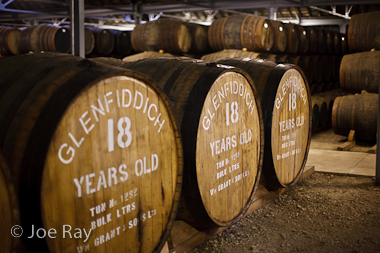
All the earth’s elements are present for making whiskies distinct and memorable
DUFFTOWN - Good Scotch whisky is a road trip in a bottle.
Pour a glass, close your eyes, breathe in, and be reminded of the place where waves turn the seaside into a rough and craggy path for the strolling thinker.
Another glass may contain a wall of smoke that overwhelms the senses, or a delicate wisp that transports you to a bog where heather becomes peat.
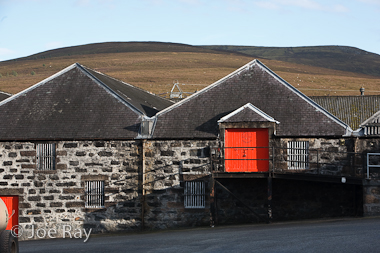 A whisky storehouse at the Glenfarclas distillery in the Speyside region - near The Balveine distillery.
A whisky storehouse at the Glenfarclas distillery in the Speyside region - near The Balveine distillery.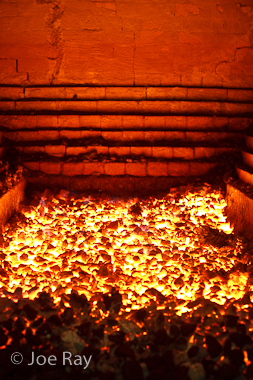 The kiln fire at The Balveine distillery in Dufftown, Scotland.
The kiln fire at The Balveine distillery in Dufftown, Scotland.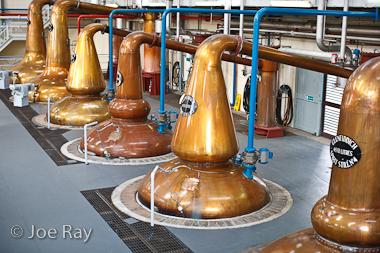 Stills at the Glenfiddich distillery - the sister distillery to Balvenie. The height and shape of each still has an effect on the flavor of the spirit they produce and the whisky at the end of the process.
Stills at the Glenfiddich distillery - the sister distillery to Balvenie. The height and shape of each still has an effect on the flavor of the spirit they produce and the whisky at the end of the process.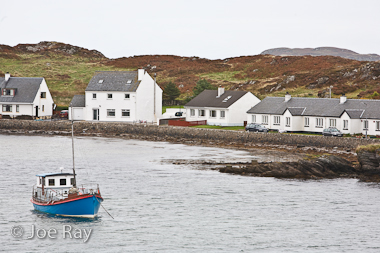 Seen from the ferry from the Scottish mainland, heather covers the hills behind the homes coming into Islay’s Port Ellen.
Seen from the ferry from the Scottish mainland, heather covers the hills behind the homes coming into Islay’s Port Ellen.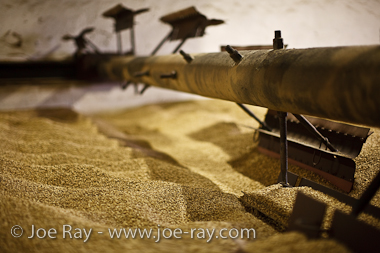 Malted barley dries in the kiln at the Bowmore distillery in Bowmore on the island of Islay.
Malted barley dries in the kiln at the Bowmore distillery in Bowmore on the island of Islay.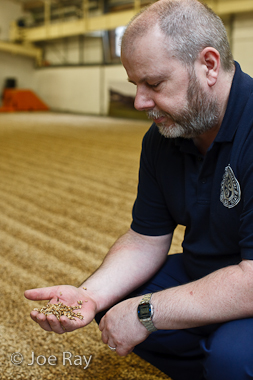 Distillery manager Malcolm Rennie inspects the barley in the ‘germination floor’ at Islay’s Kilchoman distillery.
Distillery manager Malcolm Rennie inspects the barley in the ‘germination floor’ at Islay’s Kilchoman distillery.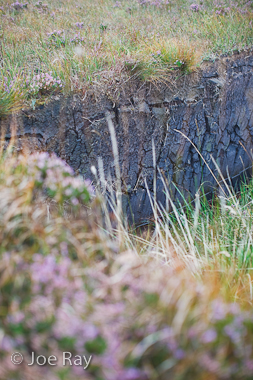 Heather grows atop peat in a bog on Scotland’s island of Islay. Particularly on Islay, peat is often used to fire kilns to dry barley, giving the whisky a smoky aroma.
Heather grows atop peat in a bog on Scotland’s island of Islay. Particularly on Islay, peat is often used to fire kilns to dry barley, giving the whisky a smoky aroma.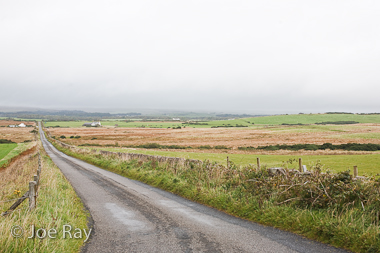 A road stretches off toward the horizon on the Scottish island of Islay.
A road stretches off toward the horizon on the Scottish island of Islay.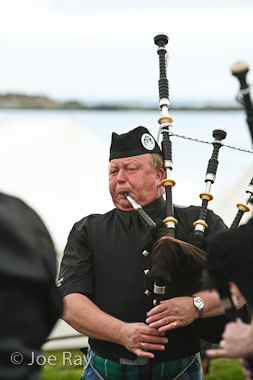 Pipe Sergeant James McEachern plays bagpipe with the Islay Pipe Band at a festival in town of Craighouse on Scotland’s island of Jura
Pipe Sergeant James McEachern plays bagpipe with the Islay Pipe Band at a festival in town of Craighouse on Scotland’s island of Jura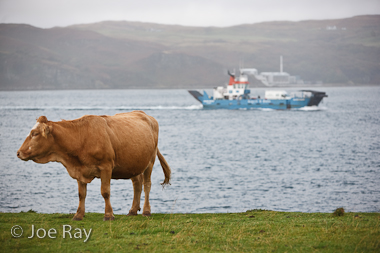 A cow on the island of Jura with the island of Islay and the ferry that connects the two between them.
A cow on the island of Jura with the island of Islay and the ferry that connects the two between them.A whisky tour through Scotland is a firsthand taste of the rocks and wind, fire and sea, mud and flowers that are a distillation of this thornily self-reliant part of the United Kingdom.
There is no single best place to tour. Scotch whiskies are divided into several main groups, each with typical flavor profiles. There’s the heather, salt, and fruit of the Highlands; easygoing Lowlands; smoky and complex Speysides; and the peaty and medicinal acquired tastes of Islay.
The best idea might be to pick an area or a few favorite distilleries and draw up an itinerary with a map. It’s hard to go wrong as long as you have a car, a tweed cap, and someone to remind you to drive on the left side of the road.There are points that are fundamental in the process of whisky-making, like the starch to sugar conversion of malting, the fermentation, distillation, and barrel aging. Other parts, such as the water’s source, the time the malt spends drying over burning peat, the shape of the stills, or proximity to the sea make each distillery’s offerings unique.
At The Balvenie along the River Spey in Dufftown, maltman Brian Nicoll is an old salt in the world of Scotch. Nicoll works at one of the few distilleries that still malts its own barley, a step most producers farm out to centralized facilities.
In a fast-clipped brogue that forces outsiders to lean in and pay attention, Nicoll explains the process, from barley arriving in trucks from southern Scotland to soaking it in tanks before setting it out to dry in a six-inch-thick layer called the germination floor.
We walk through concrete aisles and Nicoll motions for me to put my hand into the grain. It’s warm. “It’s like an electric blanket,’’ he says, sticking his hand in. “It’s the friction.’’
The soaking and slow drying force the grain to germinate, boosting its sugar content, which plays a key part in fermentation. Once the barley has begun to sprout, this “green malt’’ is dried in a giant kiln to halt the growing. If the kiln uses an appreciable amount of peat, it gives the grain a smoky nose.
Even with the help of machines, moving and turning the floor is a backbreaking process. “This place is so physical - you’re covered in sweat,’’ says Nicoll. “We call it the Balvenie gym. You work hard and feel good at the end of the day.’’
Making single-malt Scotch whisky (as opposed to a blend using spirits from multiple distilleries) is a straightforward process with thousands of variations. After malting, the grain is ground into grist and mixed with hot water in a vat called a mash tun to produce a nonalcoholic liquid called wort. This is transferred to a larger vessel called a washback where yeast is added and fermentation happens in two days of violent foaming - literally brewing to create what’s now called wash. These rooms can smell like applesauce, bubble gum, and the world’s best porridge, but stick your nose too deep into a frothing washback and you might be knocked out by the carbon dioxide that’s being produced.
From here, the liquid is distilled twice in giant, swan-necked copper stills and the best of it, known as the heart, body, or middle cut, is matured in oak barrels for at least three years.
Love at first sip is unlikely. It may take a few glasses or a few years, but slowly, like a thin road winding through fog, whisky reveals itself.
The roads between the Speyside region and Kennacraig are a driving enthusiast’s dream, flecked with micro-towns, straightaways, S-curves, views of the Loch Ness, and signs that read “Stone Skipping Championships This Saturday!’’ and “Apples £1/BOX.’’
The cafe on the ferry from Kennacraig to the island of Islay (pronounced EYE-la) is a sign of good things to come, with representatives of almost every distillery on the island behind the bar - a short and sweet selection that would blow most American bar choices away.
On the ferry, there’s an uptick in outdoor gear, boots, and wizened faces. Going up a set of stairs on the deck, the wind nearly stops me. As I look out through the rain and fog, there are sheep on a former spit of land, marooned until the tide goes out. Once Islay comes into view, the most distinctive characteristics of the untamed shoreline are the large, white distilleries, with their names in large black letters.
Luckily the car didn’t bottom out on the road up to Kilchoman distillery. The dirt track winds up through barley fields (used for some maltings) on the way to one of the only buildings for miles.
“On Islay, you work in a distillery, you work on a farm, or you’re a fisherman,’’ says Malcolm Rennie, Kilchoman manager and Islay native. “People still leave their keys in the car. Everybody waves. Once you’ve been here for a while, it’s hard to leave.’’
The son and brother of coopers, Rennie has been making whisky for 25 years, including a long stint as a mashman and distiller at Ardbeg distillery before helping found Kilchoman in 2005.
Here on a farm with horse stables, one of Scotland’s newest distilleries is, in some ways, the most traditional. “This is how it used to be. The farm produces the barley and farmers made whisky because they had all the raw materials,’’ Rennie says. “That was the ethos. It was what a distillery was.’’
That’s also the way it worked for centuries until excise taxes in the 19th and early 20th centuries squelched most home distilling. “After that, they tucked the stills into a barn,’’ Rennie says, grinning as if he still knows some bootleg operations. His distillery, one of Scotland’s smallest, isn’t too far from those early models.
Old-school or no, what Rennie and every other whisky distiller wants is to consistently create what he calls “a good, clean spirit.’’
“You design your distillery for what you want, but you still don’t know exactly what you’re going to get,’’ he says. “But people’s first taste is what they associate with the distillery. If the spirit quality drops off, I’ve got to sort it out.’’
In short, Ardbeg Ten Years Old should always taste like Ardbeg Ten Years Old.
So what if you figure out a way to change the process or even make it better? Rennie shakes his head. The question is moot. “My job is to produce a consistent product.’’
Producers get around this by offering different ages, blends, and barrelings called “expressions.’’ A Highland Glenmorangie, for instance, ages in barrels made of French or American oak or uses sherry or Sauternes casks while other whiskies are aged in a single cask.
More than 100 of these whiskies and expressions are on display behind Duffie’s Bar, a tiny whisky shrine tucked into Bowmore’s Lochside Hotel where Philip Gray and Angus Darroch tend bar.
They may make a pound or two pouring drams and pints, but money isn’t the primary motivator. Darroch is a stillman and Gray a maltman at the town’s eponymous distillery and though they may play up the ethos Rennie refers to - they’re bartenders, after all - they believe in it.
“I’ve been making whisky in the day and selling it on the weekend for 20 years,’’ says Darroch. “It’s not just the whisky.’’
The whole time we’re in Scotland, there’s no sun. On the fourth day, when we see a ray of light on a faraway hillside, it looks out of place.
Instead, an appreciation for the place comes with bursts of color from thistle, the bright head of a pheasant, defiantly red tractors, or a firm handshake. What comes with more time is an appreciation of the subtleties - shades of green, gold, blue, and even gray that keep you warm when paired with a knowing grin, good conversation, some friends, a fire, and a wee dram.
Breathe. Even if it rains, the whisky will tell you where you are.
If You Go
A visit to a distillery will take up the better part of a morning or afternoon. Many distilleries are prepared for walk-ins, but as a rule, it’s better to call ahead. Though not exhaustive, the Scotch Whisky Association’s “Distilleries To Visit†document is particularly helpful for trip planning:
Make sure to factor in time to enjoy your drives. As a Scottish friend reminded me before the trip, “The roads in the Highlands are not necessarily wide and straight!†and that pretty well applies for all of Scotland.
Where to stay
Castle Hotel
Huntly, Aberdeenshire
011-44-1466-796696
www.castlehotel.uk.com
A beautiful family-run castle. Doubles from about $160.
The Lochside Hotel
Shore Street,Bowmore
011-44-1496-810244
www.lochsidehotel.co.uk
A modest spot that overlooks Loch Indaal, houses Duffie’s Bar and boasts wonderful fare in its dining room. Doubles with breakfast about $135.
What to do
The Balvenie Distillery
Balvenie Maltings, Dufftown
011-44-1340-822-210
www.thebalvenie.com
Kilchoman Distillery
Rockside Farm
Bruichladdich, Isle of Islay
011-44-1496-850-011
www.kilchomandistillery.com
Tasting notes
Experts devote as much care and attention to whisky tasting as wine connoisseurs. Each distillery tends to have an original ‘signature’ blend and offshoots known as ‘signatures’ along with different agings. Whiskies tend to hit their stride in their teens and just get more complex from there. A few personal favorites.
Bowmore 12 Years Old - A golden wheat color with walnut, smoke, gingerbread and green almond smells. Beautiful, long-lasting, sweet aftertaste. An excellent Islay whisky and one of Scotland’s finest.
Ardbeg - This Islay distillery battles it out with the more medicinal Laphroaig for the title of “peatiest of the peaty.†I got a bottle of their Ten Years Old for Christmas last year and - with big peaty and gingerbread notes, it disappeared in a heartbeat. Fans of peat should seek out their hard-to-find “Supernova†which feels like it was wrenched from the earth’s core.
Macallan Twelve Years Old - My first-ever whisky. There’s a dark amber color in this Highland malt with vanilla, apple and waxy church-like smells. Take a sip for a subtle attack on the palate and minutes later you’ll have an aftertaste that reminds you of the Atomic FireBall you got at the village store as a kid.